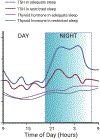The Hypothalamic Pituitary Thyroid Axis and Sleep
- PMID: 34322645
- PMCID: PMC8315115
- DOI: 10.1016/j.coemr.2020.10.002
The Hypothalamic Pituitary Thyroid Axis and Sleep
Abstract
Sleep has a bidirectional relationship with the hypothalamic-pituitary-thyroid (HPT) axis, and both these homeostatic processes are inter-dependent for robust physiological functioning. The quality and quantity of sleep influence the circadian pattern of TSH and thyroid hormone secretion. Short term sleep restriction significantly reduces the amplitude of nocturnal TSH secretion and may modulate active thyroid hormone secretion, likely through an increased sympathetic tone. Conversely, TSH and active thyroid hormone affect the quantity and architecture of sleep. For instance, low TSH values are permissive for slow wave sleep and maintenance of normal sleep architecture, while the hypo- or hyper-secretion of active thyroid hormones adversely affects the quality and quantity of sleep. Structural thyroid disorders may also be associated with an altered circadian clock - a phenomenon warranting further investigation. In this review, we aim to provide readers a comprehensive review on the associations between the HPT axis and sleep patterns.
Keywords: Hypothalamic pituitary thyroid axis; Sleep; TSH; circadian clock; thyroid hormones.
Figures


References
-
- Steiger A, Antonijevic IA, Bohlhalter S, Frieboes RM, Friess E, Murck H. Effects of Hormones on Sleep. Horm Res Paediatr. 1998;49(3–4):125–30. - PubMed
-
- Steiger A. Sleep and endocrinology. J Intern Med. 2003;254(1):13–22. - PubMed
-
- Dijk D-J, Landolt H-P. Sleep Physiology, Circadian Rhythms, Waking Performance and the Development of Sleep-Wake Therapeutics. In: Landolt H-P, Dijk D-J, editors. Sleep-Wake Neurobiology and Pharmacology. Cham: Springer International Publishing; 2019. p. 441–81. - PubMed
-
- Gronfier C, Brandenberger G. Ultradian rhythms in pituitary and adrenal hormones: their relations to sleep. Sleep Med Rev. 1998;2(1):17–29. - PubMed
Grants and funding
LinkOut - more resources
Full Text Sources
